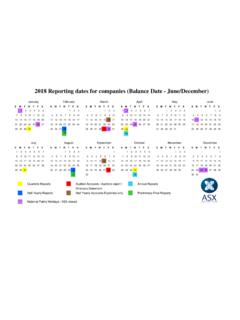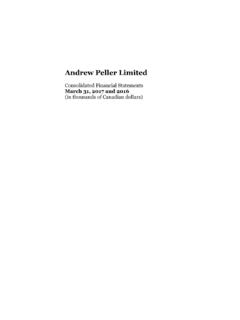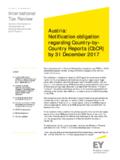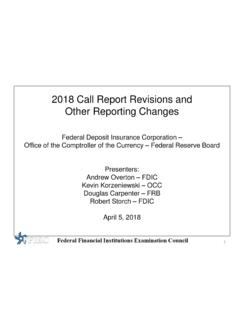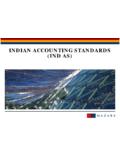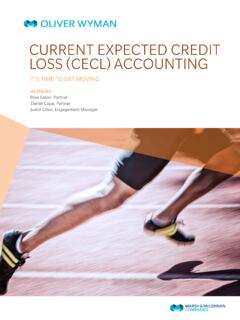Transcription of What You Need to Know Now - nakisa.com
1 SAP Lease Administration and Compliance with New Lease Accounting StandardsWhat You Need to Know NowCopyright 2017 Nakisa Inc. - Bramasol Inc. All rights reserved. 2 Table of Contents2 Executive Summary3 Overview of Leasing Challenges & Opportunities4 Why New Standards?5 Lease Administration Requirements6 SAP Real Estate Lifecycle Management7 SAP Lease Administration by NAKISA 8 Leveraging a Comprehensive Approach to Lease Management10 The Next Steps12 About Bramasol, NAKISA 14 Table of ContentsCopyright 2017 Nakisa Inc. - Bramasol Inc. All rights SummaryIn 2016, the International Accounting Standards Board (IASB) and the Financial Accounting Standards Board (FASB) issued new standards for lease accounting: IFRS 16 & ASC 842, which must be implemented by 2019. Both IFRS 16 and ASC 842 are the result of a joint effort between the IASB and FASB to meet the objective of improved transparency, comparability and financial reporting.
2 These changes will impact virtually all companies, whether lessors or eBook provides an overview of what companies need to know now and what actions you should be undertaking now to assure compliance with the new standards and to improve your overall company-wide lease management capabilities in the 2017 Nakisa Inc. - Bramasol Inc. All rights reserved. 4 Overview of Leasing Challenges & OpportunitiesThe International Accounting Standards Board (IASB) and the Financial Accounting Standards Board (FASB) have issued new requirements for lease accounting, IFRS 16 and ASC 842 that are intended to further the goal of improved transparency, comparability and financial addition to presenting a new set of challenges that need to be addressed by the end of this year, the changes in lease accounting also offer an excellent opportunity for companies to make major improvements in their end-to-end lease management companies, whether lessors, lessees or both, need to leverage the process of changing their lease management methodologies.
3 This will enable them to gain better visibility of their lease portfolios, streamline the process of lease management and reduce overall opportunities for significant improvements span all lease categories, including: Real Estate Leases Equipment Operating Leases Software LeasesAs long-term innovation partners with SAP, Bramasol and NAKISA have brought together a comprehensive set of solutions and expertise to help companies assess and prepare for the new FASB and IASB leasing standards. These solutions unify disparate leasing data and provide enhanced visibility for companies to make informed decisions on their lease portfolios, assets and liabilities while conforming with the new following sections drill down for a look at the new standards rationale and impacts, with a focus on exploring the specific solutions available and the comprehensive project roadmap needed for successful transformation of corporate lease KnowledgeProcesses ExperienceCopyright 2017 Nakisa Inc.
4 - Bramasol Inc. All rights previous accounting practices, lessees were required to classify each lease as either a finance or an operating lease. If a lease had been classified as an operating lease, then the lessee would not have shown the liability in their balance sheet. Only the periodic lease payments would show up as an expense in the company s income statements. This presented problems with lack of financial transparency, especially for non-cancellable operating leases, which represent significant liabilities that essentially were hidden from disclosure in balance absence of information about operating leases on the balance sheet meant that investors and analysts did not have a complete picture of the financial position of a company, and were unable to properly compare companies that borrow to buy assets with those that lease the large number of operating leases that exist among companies around the world, the aggregate magnitude of these undisclosed liabilities is new IFRS 16 and ASC 842 standards are designed to remove these discrepancies by requiring that most leases be shown on company balance timeframe for understanding and implementing changes to meet the new standards is rapidly becoming a critical factor for successful effective date for IFRS 16 is January 1.
5 2019 (early adoption permitted) and the effective date for ASC 842 is the next fiscal year after December 15, 2018. Why New Standards?In 2005, the US Securities and Exchange Commission (SEC) expressed concerns about lack of transparency of information about lease obligations, reiterating concerns already expressed by investors and others. Listed companies using IFRS or US GAAP disclosed almost $3 trillion of off balance sheet lease commitments in 2014 Some of America s best known companies names such as AT&T Inc., CVS Health Corp. and Delta Airlines, Inc. likely will have to effectively boost the debt that they report on their balance sheets by tens of billions of dollars. The total possible impact for all companies could be as much as $2 trillion. Wall Street Journal - Nov. 11, 2015. If you lease, regardless of your company s size or industry, under the new standards your balance sheet will be different. Now is the time to prepare for these company might not be prepared for the transition to new accounting standards due to lease data dispersed across your organization.
6 Since it is often collected by different people using different processes and mechanisms, there can be a significant variation in the quality, integrity and relevance of this data across multiple information sources. These challenges grow exponentially as lease portfolios globalize, creating a significant risk of regulatory non-compliance, as well as inaccuracy in reporting at large 2017 Nakisa Inc. - Bramasol Inc. All rights reserved. 6 For most companies, the scope of lease administration spans four major areas, depending on whether the company is a lessee, lessor, or both. As shown below, these include the following use cases:1. Lessor: property/non-movables. The use case here is commonly subtenants in real Lessor: equipment/movables, such as cars, planes, mobile phones, equipment, Lessee: property/non-movables. Virtually all companies have real estate leases for offices, facilities, land and/or Lessee: equipment/movables, such as computer equipment, production machinery, cars, planes, mobile phones, software licenses, intellectual property rights, last two areas are where most companies, as lessees, will see the greatest impacts from the new standards, which will require changes to how they collect, manage and report lease case number 4 (below) is perhaps the most challenging because of the wide range of lease contract scenarios (phones, cars, etc.)
7 And the legacy practices in many companies of letting these types of leases be handled and managed by dispersed business Administration RequirementsThe following sections discuss specific solutions by SAP and NAKISA that focus, respectively, on addressing the real estate management and operating lease administration challenges faced by lessee companies in quadrants three and four 2017 Nakisa Inc. - Bramasol Inc. All rights SAP Real Estate Management solution is a fully integrated subcomponent of SAP Finance that provides a simplified approach to the leasing solution landscape by elimination of complex financial interfaces, reduction in the number application and real time valuation of finance sharing a common platform, SAP Real Estate Management eliminates the problem with operational silos between key Real Estate Lifecycle ManagementThe leasing function is an integral part of SAP s real estate solution that covers the entire lifecycle for corporate real estate organizations across the 5 primary pillars of commercial real estate 2017 Nakisa Inc.
8 - Bramasol Inc. All rights reserved. 8 SAP Lease Administration by NAKISA is an end-to-end lease accounting solution that provides access to company-wide lease data, with the visibility and traceability needed to support and comply with the new regulatory Lease Administration by NAKISA is the result of many years of co-development between SAP and NAKISA , collaboration and consultation with key expert accounting partners, and rigorous testing through the SAP Premium Qualification process. As a certified Solution Extension, SAP Lease Administration by NAKISA goes through SAP s strict Premium Qualification program which, among others, tests and certifies the solutions for security, performance, supportability, accessibility and documentation. SAP Lease Administration by NAKISA By providing a single point of entry to collect and validate the contractual attributes of leases and assets, SAP Lease Administration by NAKISA provides visibility into a companies lease exposure to optimize assets portfolio management and supports accounting processes for more efficient cost controlling and regulatory compliance.
9 SAP Lease Administration by NAKISA creates a unified leasing contractual data repository that can be accessed to leverage accurate and relevant data for the optimization of not only the leasing accounting processes unique to your business, but also transactional processes such as equipment, supplier management, business planning, and more. To support lease accounting for regulatory compliance and drive more efficient cost controlling, companies need clear visibility into their global lease portfolios. This includes visibility into composition, key lifecycle dates, value of leased assets, responsible org units, and more. Copyright 2017 Nakisa Inc. - Bramasol Inc. All rights of this objective must begin with a unified database of lease data. By bringing the entire ecosystem of leasing data within a single unified system, SAP Lease Administration by NAKISA empowers businesses to efficiently streamline, trace, and integrate all the data on new, past and future Lease Administration by NAKISA has five major components, which are designed to manage the complexity of the lease contract administration.
10 Planning and Budgeting: Define and achieve the company s strategic outcomes and priorities in terms of equipment leasing. Data Capture & Accounting Calculations: Consolidate lease information, to calculate Lease Payment Schedule and to do the required contract classification. Equipment Tracking: Enable users to be informed with full visibility in terms of equipment installation, usage and casualties throughout the equipment lifecycle. Payment processing: Create the appropriate accounting entries required by the Accounting standards so to satisfy disclosure requirements. Event Management: Keep track of and make course corrections based on contract lifecycle events; equipment lifecycle events and Lease Payment Schedule integrated architecture for lease administration enables companies to visualize their global lease exposure at a glance on an intuitive dashboard that breaks down the composition of all assets, including contract portfolio key dates, the value of leased assets and responsible organizational units.
